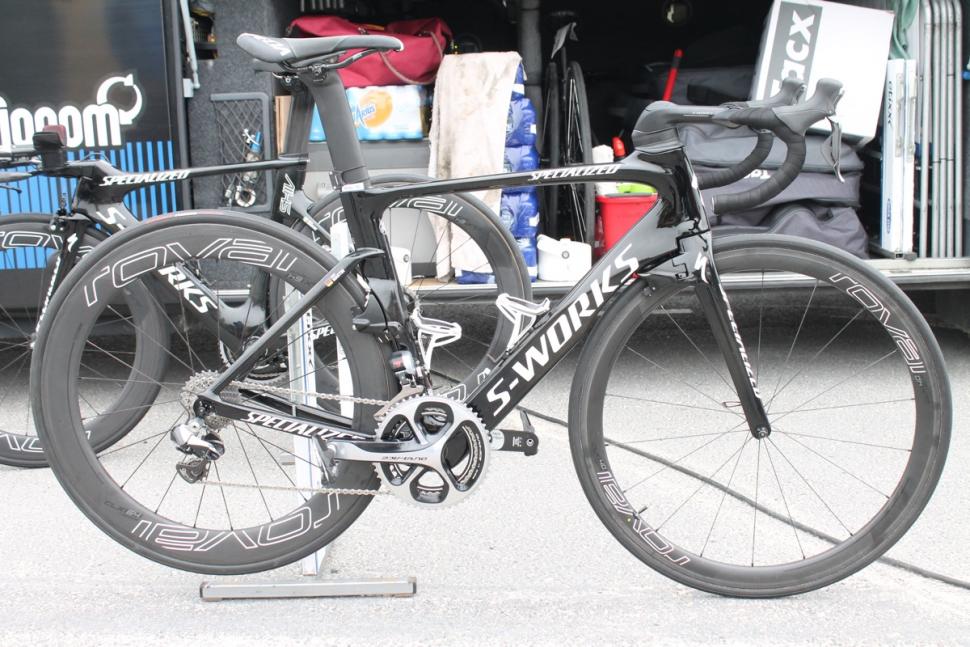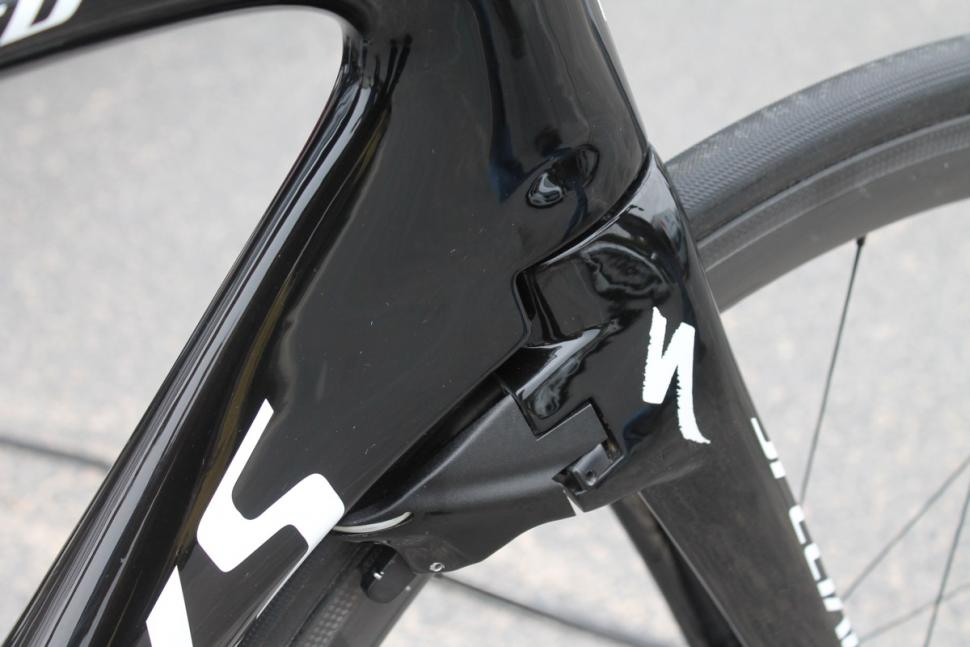- News
- Reviews
- Bikes
- Accessories
- Accessories - misc
- Computer mounts
- Bags
- Bar ends
- Bike bags & cases
- Bottle cages
- Bottles
- Cameras
- Car racks
- Child seats
- Computers
- Glasses
- GPS units
- Helmets
- Lights - front
- Lights - rear
- Lights - sets
- Locks
- Mirrors
- Mudguards
- Racks
- Pumps & CO2 inflators
- Puncture kits
- Reflectives
- Smart watches
- Stands and racks
- Trailers
- Clothing
- Components
- Bar tape & grips
- Bottom brackets
- Brake & gear cables
- Brake & STI levers
- Brake pads & spares
- Brakes
- Cassettes & freewheels
- Chains
- Chainsets & chainrings
- Derailleurs - front
- Derailleurs - rear
- Forks
- Gear levers & shifters
- Groupsets
- Handlebars & extensions
- Headsets
- Hubs
- Inner tubes
- Pedals
- Quick releases & skewers
- Saddles
- Seatposts
- Stems
- Wheels
- Tyres
- Health, fitness and nutrition
- Tools and workshop
- Miscellaneous
- Cross country mountain bikes
- Tubeless valves
- Buyers Guides
- Features
- Forum
- Recommends
- Podcast
TECH NEWS
 Tour de France 2016 Tony Martin Specialized Vias Venge - 2.jpg
Tour de France 2016 Tony Martin Specialized Vias Venge - 2.jpgTour Tech 2016: Tony Martin’s Specialized S-Works Venge ViAS
Exixx-Quick-Step’s Tony Martin was in a breakaway on today’s stage of the Tour de France aboard a Specialized S-Works Venge ViAS. He was eventually caught with about 20km (12.5 miles) to go, but let’s have a look at his bike.
We photographed this bike the day before the start of the Tour. Apologies for the cluttered background in some of the shots. Sometimes we can move the bikes to get a clear backdrop, sometimes we can’t. We bribe the mechanics as best we can but there's only so far a free pair of road.cc socks will get you.
Specialized’s Venge ViAS is an aero road bike that was launched at the beginning of last year’s Tour de France, the first bike to have been developed in Specialized's own wind tunnel (it calls it the Win Tunnel).
The Venge ViAS doesn’t have much in common with the previous Venge, with a completely new front end and a smaller rear triangle; the seat stays now meet the seat tube well below the top tube, a result of every tube shape and trailing edge having being scrutinised to make the bike faster, according to Specialized.
The brakes are proprietary integrated callipers. Specialized calls them Zero-Drag Brakes because, it claims, they create a “near-zero drag coefficient”.
Specialized says the front brake completes the fork’s trailing edge, while the rear brake drafts off the seat tube and water bottle mount.
The brakes are located in positions of minimum wheel deflection, Specialized claims, to eliminate the potential for brake rub during sprinting and to provide better braking performance.
A key change to the Venge introduced just days before the race, is an update to the brakes. Specialized engineers were over from the US to help team mechanics install the new brakes.
The updated brake has a longer spring and a new bushing from Germany’s Igus in place of the previous brass bearings. This change is said to improve lever feel and durability.
The cables pass through the Specialized S-Works Aerofly handlebar and into the stem, then through spacers that feature cable guides, and then into the frame.
It’s very neatly done.
Etixx-Quick-Step uses Shimano Dura-Ace groupsets and this bike is set up with the Di2 electronic version. You can see the junction box attached to the underside of the computer mount where it’s very accessible for on-the-fly adjustments.
This bike is set up with a 53/39-tooth chainset, and Tony Martin uses 175mm crank arms.
Etixx-Quick-Step uses crank based Precision power meters from 4iiii. This bike appears to be fitted with the version that measures only the left leg, although the team also have the Precision Pro dual sided power meter that will be released to the public very soon.
A K-Edge chain catcher stops the chain coming off the inner chainring, and those are Shimano Dura-Ace SPD-SL pedals on there.
The bike is fitted with Specialized’s Roval wheels front and rear, but they’re different depths. The rear wheel is a CLX 64, the 64 referring to the rim depth in millimetres, while the front is a CLX 40, presumably chosen for greater stability in crosswinds. The rims are carbon, including the braking surfaces, while the hubs are Specialized’s own, running on CeramicSpeed bearings.
The tyres are Specialized’s S-Works Turbos.
The saddle is from Specialized too. It looks like a Romin with carbon fibre rails. We don’t remember one exactly like this in the Specialized range (perhaps you do) although Tony Martin has been using ones similar to this for some time. There was one on his bike in last year’s Tour de France, for example.
The bottle cages are Tacx Devas. There is a carbon version of the Deva with a claimed weight of 21g but this polyamide, carbon and glass fibre version is a little heavier with a claimed weight of 29g.
Mat has been in cycling media since 1996, on titles including BikeRadar, Total Bike, Total Mountain Bike, What Mountain Bike and Mountain Biking UK, and he has been editor of 220 Triathlon and Cycling Plus. Mat has been road.cc technical editor for over a decade, testing bikes, fettling the latest kit, and trying out the most up-to-the-minute clothing. He has won his category in Ironman UK 70.3 and finished on the podium in both marathons he has run. Mat is a Cambridge graduate who did a post-grad in magazine journalism, and he is a winner of the Cycling Media Award for Specialist Online Writer. Now over 50, he's riding road and gravel bikes most days for fun and fitness rather than training for competitions.
Latest Comments
- wtjs 13 min 53 sec ago
Excellent, just the job! Thanks
- mdavidford 17 min 8 sec ago
Abrahamsen's laptop could just be connected to a power meter, no? Doesn't have to be connected to a trainer.
- the infamous grouse 1 hour 28 min ago
the terreno zero do feel a bit sluggish if the pressure isnt spot-on .. otoh the grip level and puncture resistance are pretty good. and the hex...
- Rendel Harris 1 hour 35 min ago
Good point, it's England and Wales. Northern Ireland seem to have the same minimum and maximum penalties but I don't know if they work with the...
- David9694 1 hour 50 min ago
Our car-dominated urban environment is repressive and hot - let's see if we can desecrate the countryside ...
- chrisonabike 2 hours 18 min ago
Are you confusing a clearly opinionated - nay, biased rag like road.cc with a balanced, respectable news organisation like the BBC?
- Bigtwin 3 hours 35 min ago
"Welcome to your local Council - you don't have to be a moron to work here, but it really helps if you want to blend in".
- Rendel Harris 3 hours 51 min ago
Laverack still offer the same machine in a rim brake version so the "disc" is there to differentiate it from its stablemate.
- mdavidford 4 hours 29 min ago
Quite right - get those soapboxes off our roads. As everyone knows, the right place for them is the internet.









Add new comment
1 comments
Thanks for the pictures.
Interestingly it looks like today he running a different frameset to this: the updated version has cable ports to allow the use of non-integrated bars.